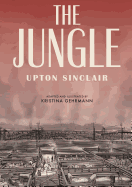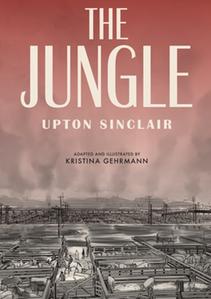
 Despite the gruesome images depicting the workings of Chicago slaughterhouses and meatpacking factories in the late 19th century and into the early 20th century, Kristina Gehrmann's graphic adaptation is a surprisingly gentler, kinder read than Upton Sinclair's 1906 novel. Credited with inciting the public outcry that resulted in both the Federal Meat Inspection Act and the Pure Food and Drug Act, The Jungle significantly influenced how and what Americans eat today. In this adaptation--smoothly translated from Gehrmann's German by Ivanka Hahnenberger--the human and animal suffering remain undeniable, the working conditions utterly unacceptable, the living situations horrifically bleak. The original unrelenting brutality, however, seems relatively contained, and the body count is similarly lessened; that said, reading this latest edition remains a chilling experience.
Despite the gruesome images depicting the workings of Chicago slaughterhouses and meatpacking factories in the late 19th century and into the early 20th century, Kristina Gehrmann's graphic adaptation is a surprisingly gentler, kinder read than Upton Sinclair's 1906 novel. Credited with inciting the public outcry that resulted in both the Federal Meat Inspection Act and the Pure Food and Drug Act, The Jungle significantly influenced how and what Americans eat today. In this adaptation--smoothly translated from Gehrmann's German by Ivanka Hahnenberger--the human and animal suffering remain undeniable, the working conditions utterly unacceptable, the living situations horrifically bleak. The original unrelenting brutality, however, seems relatively contained, and the body count is similarly lessened; that said, reading this latest edition remains a chilling experience.
In summer 1899, a multi-generational family arrives at Ellis Island from Lithuania, carrying the hope that dedicated hard work is all they need to find solid footing in the new world. A young couple, Jurgis Rudkus and his fiancée, Ona Lukoszaite, bind the group together, accompanied by various parents, an uncle, cousin and younger siblings. The clan settles in Chicago, where a friend from the old country who runs a delicatessen welcomes and feeds them, then points them to a run-down boarding house where they will initially live. Finding employment proves challenging, but not impossible; the high-risk, grueling work, however, exacts a high, even fatal, price.
Drawn into a house-purchasing scheme, the family moves into what was promised to be a new home. Ona works out the finances--every meager salary is mandatory for success--and, for a while, the family survives. But the contract they signed is anything but transparent, with undisclosed extra payments added monthly. When Ona must admit what she's been forced to do to support their growing family, Jurgis's reaction not only lands him in prison, but will prove to be the family's downfall.
Drawn in stark black and white with the occasional addition of red ink, Gehrmann's art is a spectacular, albeit disturbing, portal into Sinclair's history-making, policy-changing achievement. Those red enhancements are especially haunting; beyond the obvious devastation and carnage of meat-house slaughter, Gehrmann highlights small details to serve as warnings. Ona's bright scarf is most noticeable in the book's opening pages--an unmistakable hint that grave tragedy lies ahead, perhaps even a nod to Sinclair's original, in which Ona dies in childbirth (she's still alive in Gehrmann's ending). The next-door neighbor's facial mole, colored red, offers another haunting example; her doom-filled words to Jurgis, Ona and Ona's stepmother prove all too prescient. Each chapter's double-page introduction--a single narrative panel framed by fin-de-siècle print ads for everyday goods and services (silver spoons, plumbing repair, premium bacon)--provides contextual evidence of (manufacturing) progress marching on. While the products are publicly advertised for purchase, what happens behind those advertisements--literally--is the great American tragedy waiting to be exposed. --Terry Hong, Smithsonian BookDragon
Shelf Talker: German illustrator Kristina Gehrmann transforms Upton Sinclair's 1906 classic into an extraordinary visual rendering, reimagining an urgent exposé for modern readers.

